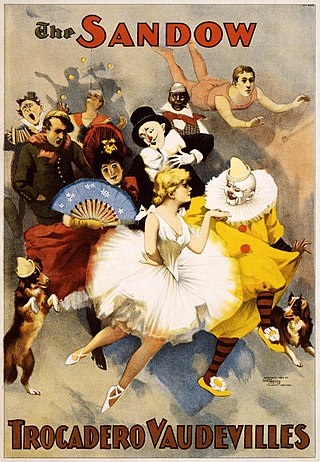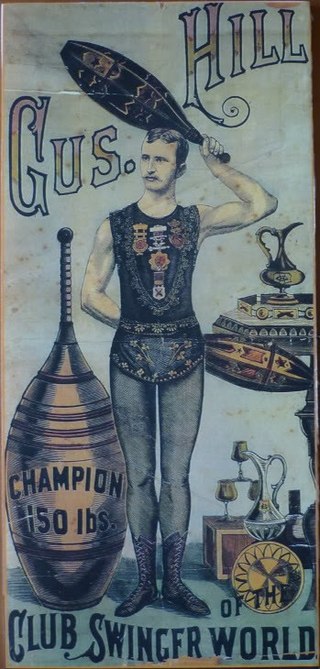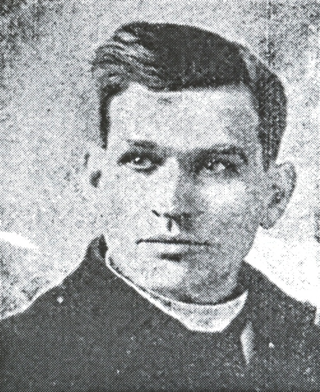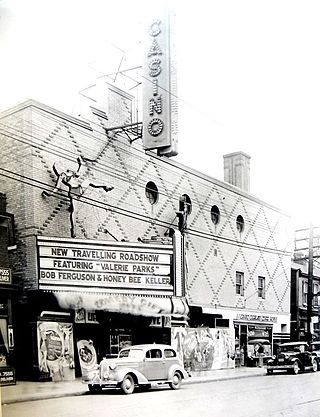
Vaudeville is a theatrical genre of variety entertainment which began in France at the end of the 19th century. A vaudeville was originally a comedy without psychological or moral intentions, based on a comical situation: a dramatic composition or light poetry, interspersed with songs or ballets. It became popular in the United States and Canada from the early 1880s until the early 1930s, while changing over time.

A revue is a type of multi-act popular theatrical entertainment that combines music, dance, and sketches. The revue has its roots in 19th century popular entertainment and melodrama but grew into a substantial cultural presence of its own during its golden years from 1916 to 1932. Though most famous for their visual spectacle, revues frequently satirized contemporary figures, news or literature. Similar to the related subforms of operetta and musical theatre, the revue art form brings together music, dance and sketches to create a compelling show. In contrast to these, however, revue does not have an overarching storyline. Rather, a general theme serves as the motto for a loosely related series of acts that alternate between solo performances and dance ensembles.
Harry Steppe, March 16, 1888 – November 22, 1934 was a Russian Jewish-American actor, musical comedy performer, headliner comedian, writer, librettist, director and producer, who toured North America working in Vaudeville and Burlesque. Steppe performed at several well-known theaters on the Columbia, Mutual and Orpheum circuits. Steppe was one of Bud Abbott's first partners.
Norman Abbott was an American vaudevillian, actor, producer and television director.

George Michael Cohan was an American entertainer, playwright, composer, lyricist, actor, singer, dancer and theatrical producer.
A tab show was a short, or tabloid version, of various popular musical comedies performed in the United States in the early 20th century.
Ralph Gilmore Allen was an American producer, director, writer, lyricist, and professor. He is credited, along with Harry Rigby with having conceived of the Tony Award-winning musical comedy Sugar Babies, a tribute to the burlesque era. In 1965, Allen was awarded the Guggenheim Fellowship in the category of Humanities.

The Passing Show was a musical revue in three acts, billed as a "topical extravaganza", with a book and lyrics by Sydney Rosenfeld and music by Ludwig Engländer and various other composers. It featured spoofs of theatrical productions of the past season. The show was presented in 1894 by George Lederer at the Casino Theatre. It was one of the first musical revues on Broadway and led the fashion for such productions. The Casino Theatre produced a revue each summer thereafter for several seasons.

American burlesque is a genre of variety show derived from elements of Victorian burlesque, music hall and minstrel shows. Burlesque became popular in the United States in the late 1860s and slowly evolved to feature ribald comedy and female nudity. By the late 1920s, the striptease element overshadowed the comedy and subjected burlesque to extensive local legislation. Burlesque gradually lost popularity beginning in the 1940s. A number of producers sought to capitalize on nostalgia for the entertainment by recreating burlesque on the stage and in Hollywood films from the 1930s to the 1960s. There has been a resurgence of interest in this format since the 1990s.

Willie Howard and Eugene Howard, billed as the Howard Brothers, were Silesian-born American vaudeville performers of the first half of the 20th century. They were two of the earliest openly Jewish performers on the American stage.
Max Liebman was a Broadway theater and TV producer-director sometimes called the "Ziegfeld of TV", who helped establish early television's comedy vocabulary with Your Show of Shows. He additionally helped bring improvisational comedy into the mainstream with his 1961 Broadway revue From the Second City.

Gus Hill was an American vaudeville performer who juggled Indian clubs. He later became a burlesque and vaudeville entrepreneur. Hill was one of the founders of the Columbia Amusement Company, an association of burlesque shows and theaters, and became president of the American Burlesque Association. He also staged drama and musical comedies. He launched a highly popular series of "cartoon theatricals", musical comedies based on comic strips or cartoons. At one time he was running fourteen different shows.

The Columbia Amusement Company, also called the Columbia Wheel or the Eastern Burlesque Wheel, was a show business organization that produced burlesque shows in the United States between 1902 and 1927. Each year, between three and four dozen Columbia burlesque companies would travel in succession round a "wheel" of theaters, ensuring steady employment for performers and a steady supply of new shows for participating theaters. For much of its history the Columbia Wheel promoted relatively "clean" variety shows featuring comedians and pretty girls. Eventually the wheel was forced out of business due to changing tastes and competition from its one-time subsidiary and eventual rival, the Mutual Burlesque Association, as well as cinemas and cruder stock burlesque companies.

Sam T. Jack, a burlesque impresario, was a pioneer of the African-American vaudeville industry in the US with his Creole Burlesque Show. He was also known for staging increasingly risqué shows in Chicago, where young women appeared wearing only skin-colored tights.
Isidore H. Herk was a burlesque manager who played a major role in the evolution of this entertainment before World War II. His show at the Gaiety Theatre, closed in 1941, was the last burlesque show on Broadway.

The Columbia Theatre was an American burlesque theater on Seventh Avenue at the north end of Times Square in Midtown Manhattan, New York City. Operated by the Columbia Amusement Company between 1910 and 1927, it specialized in "clean", family-oriented burlesque, similar to vaudeville. Many stars of the legitimate theater or of films were discovered at the Columbia. With loss of audiences to cinema and stock burlesque, the owners began to offer slightly more risqué material from 1925. The theater was closed in 1927, renovated and reopened in 1930 as a cinema called the Mayfair Theatre. It went through various subsequent changes and was later renamed the DeMille Theatre. Nothing is left of the theater.

Development of musical theatre refers to the historical development of theatrical performance combined with music that culminated in the integrated form of modern musical theatre that combines songs, spoken dialogue, acting and dance. Although music has been a part of dramatic presentations since ancient times, modern Western musical theatre developed from several lines of antecedents that evolved over several centuries through the 18th century when the Ballad Opera and pantomime emerged in England and its colonies as the most popular forms of musical entertainment.

The Casino Theatre was a live theatre, in Toronto, Ontario, Canada. It was located at 87 Queen Street West across the street from the current site of Nathan Phillips Square.

Edgar McPhail Smith was an American writer and lyricist for musicals in the early decades of the 20th century. He contributed to some 150 Broadway musicals. Weber and Fields starred in many of his works.

The Mutual Burlesque Association, also called the Mutual Wheel or the MBA, was an American burlesque circuit active from 1922 until 1931. Controlled by Isidore Herk, it quickly replaced its parent company and competitor, the Columbia Amusement Company, as the preeminent burlesque circuit during the Roaring Twenties. Comedians Bud Abbott, Lou Costello, Harry Steppe, Joe Penner, Billy Gilbert, Rags Ragland, and Billy Hagan, as well as stripteasers Ann Corio, Hinda Wausau, Gypsy Rose Lee, and Carrie Finnell, performed in Mutual shows. Mae West appeared in Mutual shows from 1922 to 1925. Mutual collapsed during the Great Depression.















